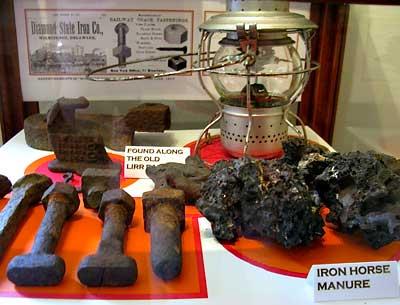Sag Harbor’s Railroad Years at Boyd House

For those who know little to nothing about the Long Island Rail Road in Sag Harbor, an exhibit at the Sag Harbor Historical Society’s Annie Cooper Boyd House through October offers a good introduction to why the village was one of the first on the East End to rally for a railroad connection.
“The Long Island Rail Road Years in Sag Harbor, 1870-1939” tells the story, from start to finish, of one of the L.I.R.R’s first branches on the East End.
The whaling industry began to decline in the 1840s as gas and oil replaced whale blubber as fuel. As a result, Sag Harbor’s economy suffered and the community felt cut off from the rest of the world. Furthermore, mass transit by land was dismally bad, and when the bay froze in the winter, residents were often stranded. A photo of one such particularly cold year, during which icicles hung from the boats, is included in the exhibit.
The exhibit takes viewers through several stages of the railroad’s history in Sag Harbor, including the building of it, its opening day, the effects it had on the economy, and its eventual demise in 1939. Most interesting, perhaps, are the many problems and community conflicts that arose in the process.
According to Jean Held, who curated the exhibit, people in the community “thought the Long Island Rail Road would connect them to the world again. It didn’t work out that way necessarily. There were some rude awakenings, like the tiny amounts they gave people for their land, and then there were promises that were broken.”
There were also countless accidents, so many that the L.I.R.R. was amusingly accused of trying to control the population. For instance, on Aug. 9, 1890, five of the seven train cars derailed. And between 1872 and ’73, fours cows were run over by trains, earning the L.I.R.R the nickname “the slaughterhouse on wheels.”
As well as photographs and newspaper excerpts that illustrate the above stories, there are also a variety of objects on display, quite a few of which Ms. Held found along the old railroad tracks, including a gas lantern, pieces of “iron horse manure” (debris left over from unburnable coal), and track fasteners. Her most exciting find was a large steel rod used to break up the coal slag that she discovered about five years ago and secreted away until this summer’s exhibit. Two L.I.R.R timetables from 1938 and 1939 are on display as well.
The historical facts presented in the exhibit are combined with personal anecdotes and amusing micro-histories. Included among them is the story of a Capt. George C. Gibbs, the founder of the Montauk Steamboat Company. Captain Gibbs took issue with the fact that the L.I.R.R. had begun demanding duty on all goods that came into the village. The baymen of Sag Harbor were used to duty-free commerce and did not comply happily with the new regulations. Captain Gibbs began running a duty-free business out of his own dock, outsmarting the L.I.R.R. and providing the community with a welcome service.
Despite the problems that surrounded the railroad, community members warmed up to it when the economy began to boom from tourism. And by the early 1900s, when the popularity of the L.I.R.R to Sag Harbor was declining, residents worried that without it, the price of coal would skyrocket. Some who visit the exhibit may actually remember riding the Tunerville Trolley, a single gas-electric car that ran between 1927 and 1939, and was the last gasp of the L.I.R.R in Sag Harbor.
The Annie Cooper Boyd house is at 174 Main Street in Sag Harbor. The exhibit can be seen on Saturdays and Sundays from 1 to 4 p.m. through Oct. 13. Admission is free.
